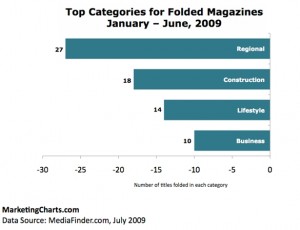 It hurts to read Bill Wyman’s blunt, sometimes savage piece on Five Key Reasons Why Newspapers Are Failing, but the veteran journalist says some things that need to be said. Unlike recent analyses that have mainly focused on the industry’s business challenges, Wyman aims his guns squarely at the editors and reporters whom he believes fostered a culture of risk-aversion and self-absorption even as the need for change grew urgent. Although the piece is heavy on anecdotes and light on statistical evidence, we found ourselves nodding in agreement frequently as Wyman ticked off a list of editorial missteps.
It hurts to read Bill Wyman’s blunt, sometimes savage piece on Five Key Reasons Why Newspapers Are Failing, but the veteran journalist says some things that need to be said. Unlike recent analyses that have mainly focused on the industry’s business challenges, Wyman aims his guns squarely at the editors and reporters whom he believes fostered a culture of risk-aversion and self-absorption even as the need for change grew urgent. Although the piece is heavy on anecdotes and light on statistical evidence, we found ourselves nodding in agreement frequently as Wyman ticked off a list of editorial missteps.
Perhaps the most damning point in the 9,000-word opus is when the author lists headlines from a “recent” (actually, it was well over a year ago) features section of an unnamed local newspaper (actually, it was the Arizona Republic). They include: “Post office food drive,” “Fight Crohn’s and colitis,” “Mom and Estában,” “Healthful salsa non-guilty pleasure,” and
“Great gifts for teachers.” The point: “There was nothing there of remote interest [to] just about any sentient being. But that’s not what the paper’s editors were aiming for. The point is that there was nothing there that could possibly offend anyone.”
Wyman hammers home this point repeatedly. In his view, advertisers and editors joined in an unholy alliance decades ago in which watchdog journalism was sacrificed to reliable and profitable ad contracts, stable circulation and don’t-rock-the-boat blandness. As a consequence, the guiding principle in editorial departments changed from informing the public to offending as few people as possible. Causing a reader to cancel a subscription was the ultimate sin. Better to under-inform than to antagonize.
As a longtime arts critic, Wyman has some stories to back up the premise. He tells of one arts editor who instructed him to avoid negativity in reviews because readers didn’t want to “hear bad things about their favorite artists over breakfast.” Reviews sections in local papers are almost unfailing positive, or at worst blasé, he notes. Arts sections are filled out with snippets from those stanchions of informational blandness: Press releases.
“Let’s be honest. Most newspapers in the U.S. aren’t watchdogs…Most papers are instead lapdogs, and the metaphorical lap they sit in isn’t even that of powerful interests like their advertisers…The real tyrant the papers served was the tender sensibilities of their readers,” he writes.
Tangled Web
The piece is equally damning in its criticism of newspaper websites, which Wyman believes are too often ponderous, difficult to use and inwardly focused. Search results return rivers of irrelevant promotions that the user doesn’t care about and that exist only to serve the interests of internal constituents, he says. External links are far too rare and readability is managed by people whose expertise is mostly in print. As a result, newspaper websites are some of the least useful properties on the Web, which is a shame because their content should be some of the most useful.
Wyman’s piece makes valuable reading, if only to hammer home the problems of a change-averse culture that still exists in many metro dailies. In part, that attitude is a hangover of management greed that has steadily pared back resources in the interest of maintaining 20% profit tax margins. However, the evils of management are a horse has been beaten to death pretty thoroughly by now. What’s different about Wyman’s perspective is that he takes editors and reporters to step to task for not doing more with the resources they have. Pack journalism and the not-invented-here mentality frustrate efforts at meaningful change. Last week’s acquisition of EveryBlock by Microsoft and MSNBC – rather than by a newspaper company — is just another indication that these businesses don’t move quickly enough.
Bloggers’ Harsh Glare
One insight that we found particularly illuminating is Wyman’s observation that the freewheeling — some would say reckless — culture of the blogosphere has cast a harsh light on the mediocrity that many newspapers have dished out for years. “The Web mercilessly exposes the flaccidness of the content of most papers. It creates a straightjacket for them: As they desperately bland themselves out on land, the material they have on hand to impress in cyberspace is correspondingly pallid,” he writes.
This point deserves special attention. Journalists like to trash talk bloggers for lacking basic journalism skills, but for all its weaknesses, the blogosphere is nothing if not interesting. Put another way, the sudden availability of massive choice exposes boring information for what it is. Big media could get away with mediocrity for many years because readers had no choice. Now that they do, the weakness of the products is magnified.
Wyman’s piece is far from perfect, being at times more tirade than exposé. But it is thought-provoking and — dare we say it — interesting. To hear him tell it, that’s a characteristic that’s all too often missing from the publications he criticizes.
Miscellany
After six quarters of stomachturning losses, newspaper companies finally reported some stability in the most recent quarter, and even a couple of upside surprises. The Wall Street Journal asks if the recovery is sustainable and largely concludes that it isn’t. One unexpected factor in the industry’s recent good fortune has been the plummeting price of paper, which is down nearly 40% in the last nine months. But the Journal expects those prices to come back as the market winnows out some weaker players. It also points to recent research indicating that marketers are more likely to cut newspaper and direct-mail spending than any other line item in the name of increasing their interactive budgets.
Rupert Murdoch’s British newspaper company plans to close the free daily thelondonpaper after reporting a ₤13 million pretax loss. Thelondonpaper is one of two afternoon free dailies, which are targeted mainly at young commuters. It lost ₤12.9 million in the fiscal year ended June 2008 on revenue of just ₤14.1 million. About 60 jobs are affected, though it’s not clear how many people will lose their jobs.
Marty Petty, a Pulitzer Prize-winning journalist-turned-successful-publisher, will leave the St. Petersburg Times after nine years. Calling the apparently voluntary move a “business decision” that reflects the shrinking size of the newspaper, Petty said management must adjust along with employees. Petty was a member of two Pulitzer Prize-winning teams at the Kansas City Star and Times in 1982. She later joined the Hartford Courant, where she rose to the position of associate publisher. She was named the Tampa Bay Business Journal’s BusinessWoman of the Year for media in 2005.
 What do journalists and porn stars have in common? Plenty, according to a short piece in New York magazine. Jessica Pressler writes that pornographers who were making good money online just a couple of years ago are suddenly confronting a new threat from amateur videographers who are giving away all the sex you can watch for free. Once highly paid porn stars are complaining that they can’t find work and there’s little new blood coming into the system. Pressler suggests that maybe The New York Times ought to steal a page from the porn industry by focusing more on stars than on programs. That means orchestrating the careers and various activities of its best reporters instead of simply publishing their stuff.
What do journalists and porn stars have in common? Plenty, according to a short piece in New York magazine. Jessica Pressler writes that pornographers who were making good money online just a couple of years ago are suddenly confronting a new threat from amateur videographers who are giving away all the sex you can watch for free. Once highly paid porn stars are complaining that they can’t find work and there’s little new blood coming into the system. Pressler suggests that maybe The New York Times ought to steal a page from the porn industry by focusing more on stars than on programs. That means orchestrating the careers and various activities of its best reporters instead of simply publishing their stuff.
 Alan Mutter interviews Jeremy Halbreich, the newly installed CEO of the bankrupt Sun-Times Media Group (STMG). Halbreich (right) says that contrary to popular belief, the Sun-Times is gaining market share against the Tribune and that new owners are ready to invest more than $10 million in streamlining and modernizing the paper’s internal processes.
Alan Mutter interviews Jeremy Halbreich, the newly installed CEO of the bankrupt Sun-Times Media Group (STMG). Halbreich (right) says that contrary to popular belief, the Sun-Times is gaining market share against the Tribune and that new owners are ready to invest more than $10 million in streamlining and modernizing the paper’s internal processes.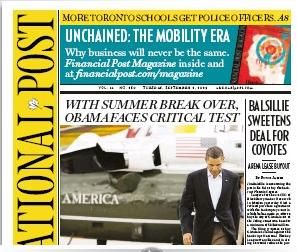 National Post Returns on Mondays
National Post Returns on Mondays Newspaper layoffs have hit young people the hardest
Newspaper layoffs have hit young people the hardest

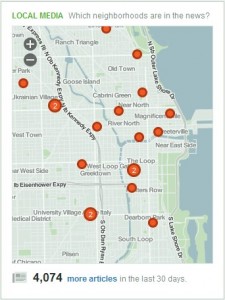

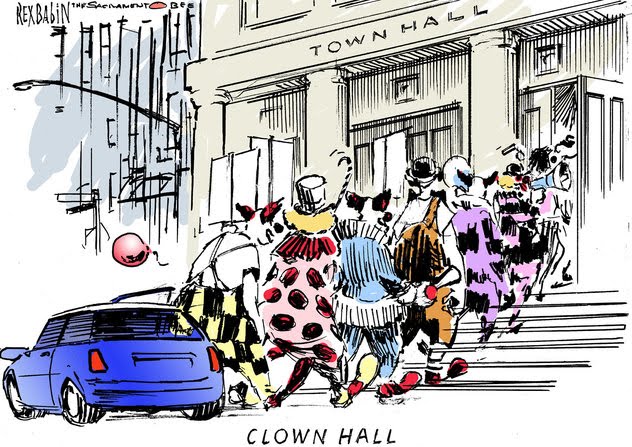
 Ken Doctor is one of those rare breed of editors who understands the business side of newspapering. After spending nearly 25 years as an editor at papers ranging from alternative weeklies to the St. Paul Pioneer Press, he moved to Knight Ridder corporate to help lead the company’s push into new media. Doctor ultimately worked on editorial, strategy and content services for Knight Ridder Digital,
Ken Doctor is one of those rare breed of editors who understands the business side of newspapering. After spending nearly 25 years as an editor at papers ranging from alternative weeklies to the St. Paul Pioneer Press, he moved to Knight Ridder corporate to help lead the company’s push into new media. Doctor ultimately worked on editorial, strategy and content services for Knight Ridder Digital, 


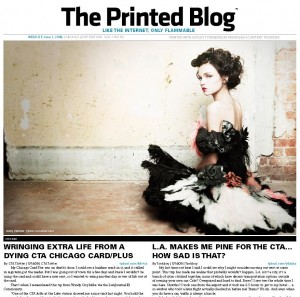
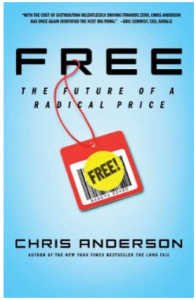
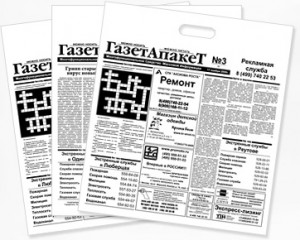 The comedy team of Bob & Ray once had a skit about an idea called edible food packaging. It turns out the notion may not have been so far-fetched, as publishers are trying every possible idea to make their print products palatable. In Moscow, the the
The comedy team of Bob & Ray once had a skit about an idea called edible food packaging. It turns out the notion may not have been so far-fetched, as publishers are trying every possible idea to make their print products palatable. In Moscow, the the  Another group of Rocky Mountain News ex-pats is
Another group of Rocky Mountain News ex-pats is 